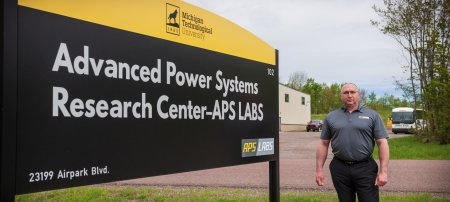Research engineer Venkata Rajesh Chundru, who secured his first patent in the summer of 2020, turns his camera starward and strays beyond his expertise area to think out of the box.
Chundru ’17 ’19 came to the Keweenaw to pursue graduate studies in 2014, and his photography has delighted thousands with the boundless wonder of the sky. For the mechanical engineering-engineering mechanics alumnus, capturing and sharing his imagery served as both a creative outlet and inspiration to continue probing the unknown.
“My off-hours photography of stars and northern lights were a great inspiration,” Chundru says. “It kind of encouraged me to think out of the box, which is one of the important qualities for coming up with new ideas.”

While at Tech, Chundru focused on modeling and control systems design of diesel aftertreatment systems. Now a research engineer specializing in advanced algorithms and powertrain controls at Southwest Research Institute (SwRI) in San Antonio, Texas, his work in this area continues.
Chundru’s patent focuses on a novel aftertreatment system to meet future Environmental Protection Agency (EPA) and California Air Resources Board emission regulations, including nitrogen oxides (NOx ) and particulate matter (PM) for heavy-duty diesel engines. “It’s relevant to the research work I performed at Michigan Tech as part of my PhD and this patent,” says Chundru. “I also work on electric vehicle design and connected vehicle programs.”
“Production diesel engines employed in on-road trucks typically are regulated by the EPA in terms of how much tailpipe NOx and PM they can emit, which is measured in g/bhp-hr (grams per brake horsepower-hour),” Chundru explains. “The present US standard limits road vehicles to 0.2 g of NOx/bhp-hr. However, future standards aim at limiting this to 0.02 g/bhp-hr (a 90% reduction) to prevent smog in major cities like L.A. and New York. This helps reduce respiratory diseases such as asthma and the severity of novel diseases such as COVID-19.”
While photography was an important counter to long hours in the lab, Chundru says tireless time and effort invested in the research process, along with continuous interaction and technical discussions with advisors Gordon Parker and John Johnson of the ME-EM department were the most essential components of his success.
“With the goal of meeting the new standard I was able to work with Dr. Parker and Dr. Johnson to design an aftertreatment system that modified the existing production system with an addition of a second diesel oxidation catalyst (DOC) that greatly improved system performance up to 95% in terms of NOx and also helped reduce fuel consumption of the diesel engine,” says Chundru.
“This patent uses the chemical reactions already taking place in existing systems (oxidation of NO and NOx reduction) to our advantage and smartly applies them in real time using control algorithms—which are also part of this patent,” he says.
Chundru says taking advantage of these naturally occurring chemical reactions and controlling them based on algorithms they developed is the most exciting part of the patent. “This blend of chemistry and its control by algorithms is unique to this work,” he says. “At the same time, this is a practical application of technology that can go into production in the next few years and have a positive impact on the quality of air and health of people. That is quite exciting as well.”

Chundru continues to pursue patents as well as photography, drawing further parallels between both his postgrad work and endeavors at SwRI as he continues on his innovation path. “My work focuses on aspects of diesel engines that are similar to this patent. As a result I have recently applied for a US patent on a similar control system with a third patent idea in development,” he says. “They are still in the draft phase so I can’t get into details. But I intend to keep developing such designs, control systems through patents and real-world demonstration programs.”
Chundru says Michigan Tech is fertile ground for inventors. “The focus at Michigan Tech on good coursework curriculum combined with a practical approach to teaching in the labs such as APS (Advanced Power Systems Labs) play an important role in encouraging students like me to innovate.”
Asked if he has advice for other Michigan Tech students and grads who might want to secure patents, Chundru encourages them to look outside their preconceived boundaries.
“Keep working on a topic that is of interest to you and never shy away from exploring areas of research which are slightly out of your area of expertise,” he says. “It’s only when we combine ideas from other fields—without relying solely on our area of expertise—that we end up with innovative ideas. A good example is this patent. Folks who work on control systems usually tend to think of operating constraints they work in and folks working with catalysts tend to maximize performance of chemical reactions but leave out the active controls part. It’s only when you combine areas like these that you end up with innovative ideas.”
"And last but not least, no idea is too unrealistic. When we come up with a new idea it typically sounds infeasible—but that's the whole point. If it is obvious then it would have been out there already."
Michigan Technological University is an R1 public research university founded in 1885 in Houghton, and is home to nearly 7,500 students from more than 60 countries around the world. Consistently ranked among the best universities in the country for return on investment, Michigan's flagship technological university offers more than 120 undergraduate and graduate degree programs in science and technology, engineering, computing, forestry, business, health professions, humanities, mathematics, social sciences, and the arts. The rural campus is situated just miles from Lake Superior in Michigan's Upper Peninsula, offering year-round opportunities for outdoor adventure.






Comments